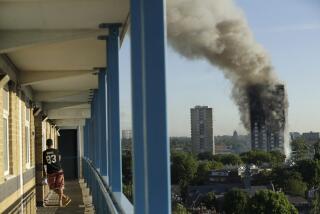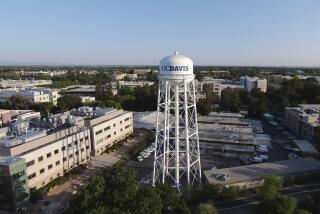Toll in Moscow Blaze Rises to 36
- Share via
MOSCOW — Students who clutched blankets to catch victims leaping from the windows of a burning university dormitory block here said Monday that firetrucks took more than half an hour to arrive and then had inadequate water pressure to fight the fast-moving blaze, which killed 36 foreign students and injured 170 others.
Describing a scene of pandemonium and fear, witnesses said that firefighters had to cut through steel gates to reach the building and that the first two trucks could not spray enough water to keep the fire from racing to the top of the five-story building, where students were screaming for help and leaping from windows.
The fire, which devastated the 19,000-student community of Peoples Friendship University -- once a showcase of Soviet patronage of the Third World -- was the worst blaze in Moscow in 26 years.
“People still inside the building were shouting, ‘Help us, save us!’ The entire building was ablaze, and people were so desperate, they were jumping out the windows,” said Idibek Sharipov, an 18-year-old student from Tajikistan. “There was little anyone could do, because everything was covered with smoke. It was really hell on Earth.”
Most of the dormitory’s 272 registered residents were from Africa, Asia, Latin America and the Caribbean.
A Fire Department official told Russia’s official news agency there was a 40-minute delay in responding to the fire but it blamed students, saying they tried to put out the blaze before calling authorities.
Students said there was little they could do against the fire.
“There were no systems at all. The extinguishers didn’t work. We began running and tried to stamp on the fire with our feet,” said Gabriela Olivo, a 19-year-old pharmacy student from Ecuador.
Olivo said she woke up about 2 a.m. and found the hallway outside her second-floor room filled with smoke. Within minutes, she said, the electricity went out.
“When the lights went out, everybody was just shouting and screaming. We couldn’t see anything, and we couldn’t breathe,” Olivo said. “People started jumping through the windows.”
The stairway at one end of the hall was filled with fire, but Olivo made her way to safety down the smoke-filled stairway at the other end of the building.
“At the beginning of the fire, only one engine came. It came after 45 minutes,” said a law student from the Dominican Republic living in an adjacent dormitory, who declined to give his name for fear he would be expelled.
“We waited and waited. When the first firetruck came, only three rooms were on fire. But the fire was on the main exit side, and people couldn’t get out,” he said. “The emergency exit is usually locked. Believe me, I know.... I live in the same block, and it’s always locked at night.”
The fire began to spread up to the fifth floor, and the first two trucks were unable to project water that high, he said. He estimated it took the trucks 20 minutes to connect to hydrants to boost water pressure. “By that time, there were countless people up there [at the fifth-floor windows]. And of course, people were jumping. Wouldn’t you have jumped?”
He said many appeared to survive the jump but were badly injured. “It was terrible. Bones were sticking out through their arms, from their legs, their jawbones sticking out.”
“We took whatever we had, either a blanket or a bedsheet, and we spread it out for people to jump into,” said Edwin Ayala, a student from Guatemala.
Eventually, the courtyard was filled with firetrucks and ambulances, but they were too late for many students.
University officials said rescue efforts were hampered because nearly all of the students had been in the country less than a month and spoke no Russian. The dorm was a special quarantine unit for students newly arrived from developing countries. Students from those areas are not allowed to leave the dorm during their first month pending medical checks in order to halt the spread of diseases such as tuberculosis and AIDS, school officials said. But they said the doors were never locked.
Yevgeny Shesuyak, head of the campus emergency situations office, said the fire appeared to have started in a room shared by three girls on the second floor, possibly from a faulty electrical device.
Shesuyak said he arrived an hour after the fire began, adding: “When I came to the site, there were more than 50 engines deployed here. The firefighters did everything they could to save people, but the fire was of a tremendous, unbelievable force.”
He said a special lift was used along with ladders, as was a powerful water gun.
“The problem was the temperature of this building -- firefighters were physically unable to get into the building,” he said. “They would knock the fire back for a moment, but it would start up again.”
Nikolai A. Kovalchukov, the university rector’s spokesman, agreed with students that more people would have been saved if the emergency response had been faster.
“If there had been more coordination in their work, we could have avoided some of the casualties,” he said, noting that the blaze had not spread past the second floor when the first firetrucks arrived. “I don’t know why the fire service was unable to stop the spread of the fire. So I think the fire service must assume part of the blame. They had the equipment they needed. It was their work on site, their performance and coordination, that causes doubt.”
Students said the condition of the dorms had many of them wondering when a disaster might happen. Many said that the heating was inadequate and that students had their own portable heaters.
“Have you seen the bathrooms? They’re a total nightmare.... If you could put even $5,000 a year for maintenance of this building, you could do something. But they don’t care,” said Sofia Alvarenga, a student from El Salvador.
Many students thought they were going to Russia’s finest university, she said.
“They showed us beautiful pictures of Moscow State University, and that’s what we thought we were signing up for. But we come here, and it’s totally different,” Alvarenga said. “What can we do? We came here 36 hours by plane. Most people don’t have the $1,500 airfare to go home.
“And now we have to explain this fire to our parents,” she said. “We told them when we came, ‘Let us go for a year or two, looking for our future.’ It was so hard for our parents to let go of us. Now how do we tell them what happened?”
More to Read
Sign up for Essential California
The most important California stories and recommendations in your inbox every morning.
You may occasionally receive promotional content from the Los Angeles Times.













